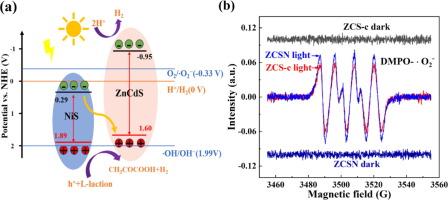Z-scheme NiS@ZnCdS heterostructures and their boosted photocatalytic H2 evolution
IF 6.9
2区 材料科学
Q2 CHEMISTRY, PHYSICAL
引用次数: 0
Abstract
Due to exceptional photocatalytic hydrogen evolution properties, ZnCdS is considered as a promising strategy to enhance the photocatalytic hydrogen evolution performance of ZnCdS with introducing sulfur vacancy or constructing heterostructures. Here, sulfur vacancy-rich ZnCdS nanoparticles were synthesized via a straightforward co-precipitation method followed by a high-temperature annealing treatment. Then NiS@ZnCdS composites were prepared with the hydrothermal method after mixed the precursors of Ni(Ac)2·2H2O and CH4N2S with the prepared Zn0.5Cd0.5S powders. Thereafter, the prepared samples were used as photocatalysts for hydrogen production. The results showed that the optimized NiS@ZnCdS heterostructures has a photocatalytic hydrogen production rate of 42 mmol · g−1·h−1, which is 14 times higher than that of the ZnCdS sample without annealing treatment. The mechanism behind has been analyzed. A staggered band energy alignment between NiS and ZnCdS was constructed from the measurements of ultraviolet photoelectron spectroscopy (UPS) and XPS spectra, and a z-scheme charge transfer mode was proposed between NiS and ZnCdS with an assistance of electron spin resonance (ESR) signals of •O2−. The z-scheme heterostructure between NiS and ZnCdS can enhance the separation of photogenerated electron-hole pairs and increase the photocatalytic activity. The studies will be helpful to construct the NiS related heterostructure.


Z 型 NiS@ZnCdS 异质结构及其增强型光催化 H2 演化
由于ZnCdS具有优异的光催化析氢性能,因此通过引入硫空位或构建异质结构来提高ZnCdS的光催化析氢性能是一种很有前途的策略。本文通过高温退火处理后的共沉淀法合成了富含硫空位的ZnCdS纳米颗粒。将Ni(Ac)2·2H2O和CH4N2S前驱体与制备的Zn0.5Cd0.5S粉末混合后,采用水热法制备NiS@ZnCdS复合材料。然后,将制备的样品用作制氢的光催化剂。结果表明,优化后的NiS@ZnCdS异质结构的光催化产氢速率为42 mmol · g−1·h−1,是未经退火处理的ZnCdS样品的14倍。并对其机理进行了分析。通过紫外光电子能谱(UPS)和XPS光谱的测量,构建了NiS和ZnCdS之间的交错能带能量对准,并在•O2−的电子自旋共振(ESR)信号的辅助下,提出了NiS和ZnCdS之间的z-scheme电荷转移模式。NiS和ZnCdS之间的z-scheme异质结构可以增强光生电子-空穴对的分离,提高光催化活性。这些研究将有助于构建NiS相关异质结构。
本文章由计算机程序翻译,如有差异,请以英文原文为准。
求助全文
约1分钟内获得全文
求助全文
来源期刊

Applied Surface Science
工程技术-材料科学:膜
CiteScore
12.50
自引率
7.50%
发文量
3393
审稿时长
67 days
期刊介绍:
Applied Surface Science covers topics contributing to a better understanding of surfaces, interfaces, nanostructures and their applications. The journal is concerned with scientific research on the atomic and molecular level of material properties determined with specific surface analytical techniques and/or computational methods, as well as the processing of such structures.
文献相关原料
公司名称
产品信息
阿拉丁
Ethanol (C2H5OH)
阿拉丁
Sodium sulfide (Na2S)
阿拉丁
Thiourea (CH4N2S)
阿拉丁
Nickel acetate tetrahydrate (Ni(Ac)2·2H2O)
阿拉丁
Zinc acetate dihydrate (Zn(Ac)2·2H2O)
阿拉丁
Cadmium acetate dihydrate (Cd(Ac)2·2H2O)
 求助内容:
求助内容: 应助结果提醒方式:
应助结果提醒方式:


